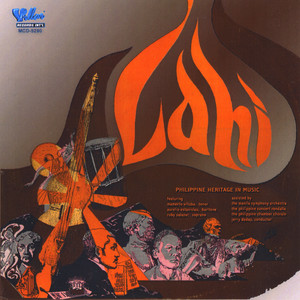
LAHI
- 流派:World Music 世界音乐
- 语种:英语
- 发行时间:1972-01-01
- 类型:录音室专辑
- 歌曲
- 时长
简介
LAHI is an unusual achievement in Philippine recording history. Conceived by tenor Mamerto Villaba in cooperation with the Villar Recording Company, serves as a fund-raiser for the Cultural Foundation of Quezon City. LAHI also seeks to acquaint our youth and our countrymen with the great aspirations and thoughts of our national heroes through the universal language of music. By so doing, it is the foundation’s intention, through this recording, to rekindle in Filipinos a greater love of country which could lead to a more constructive and vigorous nationalism. The first impression that one gets after listening to LAHI is that it called for a great deal of study, research, re-scoring and discussions before the musicians and soloists were assembled for the project. Album of Patriotic Music Some of the selections in this album, notably La Deportacion, lyrics and music by Dr. Jose P. Rizal; Sinta’y Tatahimik, from a poem entitled Kundiman also by Dr. Rizal; Ultimo Adios, based on the hero’s immortal poem; and Sumikat Na, with lyrics by Andres Bonifacio; had to be dug up from private collections of Rizalistas like the eminent Dr. Antonio J. Molina. For all our oft-repeated advocacy of nationalism, which have been going on for decades now, it had to take the Cultural Foundation of Quezon City to produce an album of patriotic music, featuring the verse and music of our national heroes. If only for this aspect , the producers of LAHI truly deserve to be commended. This recording was also made possible by the invaluable assistance of Victor Puyat, executive vice-president and general manager of the Loyola Group of Companies. THE SELECTIONS 1). BAYAN KO – has not lost its appeal, particularly to the masses. It is even more popular these days among the country’s youths and is invariably sang during demonstrations. The lyrics were penned by the well-known poet, Jose Corazon de Jesus. The music was composed by Constancio de Guzman, who has a number of classic songs to his credit. Tenor Villaba on vocals and orchestration and choral arrangement by Jerry Dadap. 2). LA DEPORTACION – echoes the longing of Dr. Jose P. Rizal when he was exiled to Dapitan in Zamboanga in July 1892. Both the lyrics and music were written by the hero , which reveals another facet of his creativity and genius. Mr. Villaba gives credit to Dr. Antonio J. Molina, the musicologist and an ardent Rizalist, for lending him a copy of this rare song. The tenor had it rearranged for voice and piano by Ignacio C. Reyes. The orchestral arrangement, as in most of the other numbers, was done by Jerry Dadap. Mr. Villaba first sang La Deportacion in a concert in Dapitan. 3). SINTA’Y TATAHIMIK – is based on a poem, “Kundiman” by Dr. Jose P. Rizal. Ignacio C. Reyes who wrote the music, has dedicated it to tenor Villaba. In its lyrics, the hero rallies the oppressed nation to rise for freedom. 4). ULTIMO ADIOS – an art song composed by the famous Nicanor Abelardo, utilizes the first three and the final stanzas plus the last line ( To die is to rest) of the immortal poem written by Dr. Rizal on the eve of his execution. Some members of Spain’s “Real Academia de la Lengua” considers it the most touching farewell poem written in Spanish. Mr. Villaba first heard this song ,rendered by a female choir under the direction of Dr. Molina shortly after World War II. Touched by its beauty and lofty sentiments, he borrowed a copy of the score from Dr. Molina. Mr. Villaba had it rewritten as a solo for tenor. On one of his performance, Mr. Villaba was accompanied by the Manila Symphony Orchestra. Orchestration and choral arrangement by Jerry Dadap. 5). MAY PAG-ASA PA – was composed by Julian C. Balita. Levi Celerio wrote the lyrics. This song reminds the people that if they want the good life, they should shake off their complacency. 6). MAGKAISA NA, NGAYON DIN – was also composed by Julian Balita and lyrics by Levi Celerio. It appeals for unity for our Motherland. 7). SA SARILING BAYAN - is another song that tenor Villaba traces to his boyhood days. Having lost his copy of the words and music, Villaba had it transcribed by Ignacio C. Reyes. He has thus far been unsuccessful in tracing the lyricist and in getting the full name of the composer, who for the moment shall be known only by his surname, Tolentino. The lyrics seem to have been inspired by “The Song of Maria Clara” written by Dr. Rizal, especially the portion, “Kay tamis mabuhay sa sariling bayan.” Orchestration and choral arrangement by Jerry Dadap. 8). SUMIKAT NA ANG ARAW – was composed by Jerry Dadap in 1963 to a poem by Andres Bonifacio, “Katapusang Tawag.” It was first performed in March 1968 by tenor Villaba, accompanied by the Concert Philippines Orchestra under the direction of the composer. 9). ALAY SA INANG BAYAN (CHORAL SYMPHONIC ODE NO. 1) – For Chorus, Rondalla and Orchestra is another Jerry Dadap composition featuring the well-known soprano , Ruby Jose Salazar and a cello solo by Mina Atienza. Alay sa Inang Bayan was first performed in 1965 at the Philamlife Auditorium, with the composer conducting. The composition was written for the Bonifacio National Centennial Composition contst in 1963. It is in three major sections- the prologue, transition and choral. Text is by Castor Lee Amper Jr.

